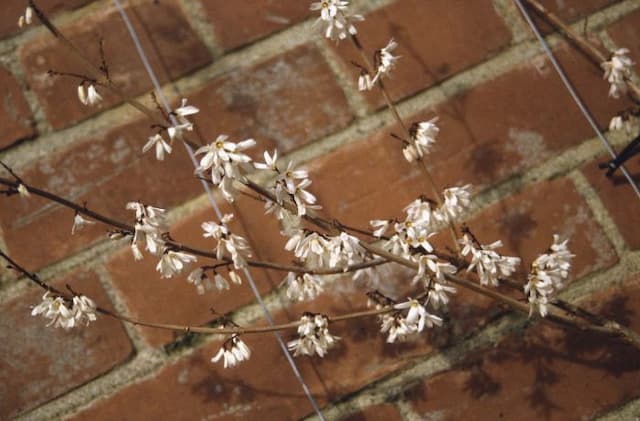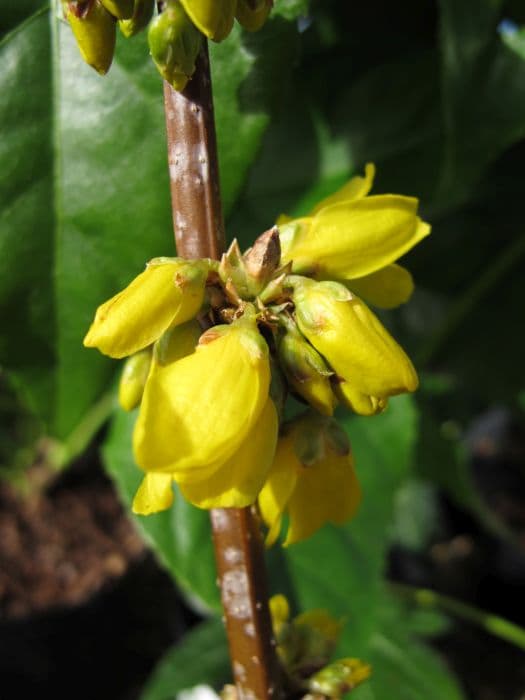False Holly Osmanthus heterophyllus 'Gulftide'

ABOUT
Osmanthus heterophyllus 'Gulftide', commonly known as False Holly, is an evergreen shrub with a dense, rounded growth habit. Its visual appeal is mainly due to its glossy, leathery leaves which have a dark green color and are often described as holly-like because of their spiny margins. The leaves typically have multiple spines on the leaf margin, and they can give a prickly feel when handled. Over time, the leaves may become less spiny and more ovate. In the fall, the False Holly produces small, fragrant white flowers which are followed by not particularly showy fruits that can attract birds to the garden. The flowers add a subtle charm to the plant and are sometimes hidden among the foliage. Overall, the plant provides year-round interest with its textured leaves, fragrant flowers, and the potential for seasonal fruit.
About this plant
 Names
NamesFamily
Oleaceae.
Synonyms
False Holly, Holly Olive, Holly Osmanthus, Variegated False Holly, Gulftide.
Common names
Osmanthus heterophyllus 'Gulftide'.
 Toxicity
ToxicityTo humans
False Holly is not commonly recognized as a toxic plant to humans. Therefore, ingestion typically does not lead to serious poisoning. However, as with many plants, individual sensitivities can vary, and consumption of plant parts is generally not advised. If someone were to have a sensitivity to the plant, they might experience mild gastrointestinal upset or an allergic reaction.
To pets
False Holly is similarly not listed as a toxic plant to pets such as dogs and cats. It is generally considered non-toxic, and ingestion should not result in serious harm to most pets. However, gastrointestinal irritations might occur if a pet eats large quantities of the plant. Symptoms could include vomiting or diarrhea, although these are not commonly reported. Always exercise caution and prevent pets from consuming plants not meant for their consumption.
 Characteristics
CharacteristicsLife cycle
Perennials
Foliage type
Evergreen
Color of leaves
Green
Flower color
White
Height
6-10 feet (1.8-3 meters)
Spread
6-8 feet (1.8-2.4 meters)
Plant type
Shrub
Hardiness zones
7-9
Native area
Japan
Benefits
 General Benefits
General Benefits- Aesthetic Appeal: Gulftide, as an evergreen shrub, provides year-round visual interest with its glossy green leaves and significant structural form.
- Low Maintenance: This variety requires minimal care once established, with infrequent pruning to keep its shape.
- Drought Tolerance: Gulftide is known for its ability to withstand periods of low water availability, making it suitable for xeriscaping.
- Pest Resistance: The plant shows strong resistance to common pests and diseases, reducing the need for chemical treatments.
- Versatility in Landscaping: It can be used as a hedge, screen, specimen plant, or group planting, offering various landscaping options.
- Wildlife Attraction: The flowers can attract pollinators such as bees, while the dense foliage provides shelter for birds.
- Fragrant Flowers: Gulftide produces small yet fragrant white flowers in the fall, adding a sensory benefit to gardens.
- Durability: It is tolerant of urban conditions like air pollution and can thrive in a variety of soil types, making it suitable for different urban and suburban settings.
- Seasonal Interest: In addition to its evergreen nature, the new growth may exhibit a reddish tinge, and fall flowers add temporary color and interest.
 Medical Properties
Medical PropertiesThis plant is not used for medical purposes.
 Air-purifying Qualities
Air-purifying QualitiesThis plant is not specifically known for air purifying qualities.
 Other Uses
Other Uses- Topiary Art - Osmanthus can be shaped into precise topiary forms, providing a sculptural element to gardens and landscapes.
- Natural Perfumery - The blooms of 'Gulftide' can be used in the creation of natural perfumes due to their sweet, fragrant odor.
- Culinary Garnish - Although not widely known for culinary uses, the small flowers could potentially be used as an edible garnish for special dishes.
- Theme Gardens - Osmanthus 'Gulftide' can be featured in Asian-themed gardens to represent the flora of Eastern cultures where it is more commonly found.
- Privacy Screens - The dense foliage makes it suitable for creating privacy screens in residential gardens.
- Wildlife Shelter - The thick, spiny leaves provide shelter and a safe nesting area for certain species of birds and insects.
- Hedge Borders - They can be planted in a row to form attractive and resilient hedge borders.
- Bonsai - With its small leaves and tolerance for pruning, 'Gulftide' can be trained and grown as a bonsai tree.
- Artistic Inspiration - The striking appearance of Osmanthus 'Gulftide', especially when in bloom, can be a source of inspiration for artists and photographers.
- Potpourri Ingredient - Dried flowers and leaves can contribute fragrance and texture to homemade potpourri blends.
Interesting Facts
 Feng Shui
Feng ShuiThe plant_name is not used in Feng Shui practice.
 Zodiac Sign Compitability
Zodiac Sign CompitabilityThe plant_name is not used in astrology practice.
 Plant Symbolism
Plant Symbolism- Peace: Osmanthus flowers are often associated with peace due to their tranquil and pleasing scent, which can have a calming effect.
- Good Fortune: In East Asian cultures, osmanthus is symbolic of good luck and is often used in festive occasions and celebrations.
- Nobility: The sweet and noble fragrance of the Osmanthus, especially when in bloom, has historically been linked with high status and aristocracy in some cultures.
- Feminine Beauty: The delicate beauty of the Osmanthus flowers has made them a symbol of feminine allure and attractiveness.
- Love and Romance: The alluring scent of the Osmanthus flower is sometimes associated with love and romance, making it a symbol of amorous feelings.
- Perseverance: Since Osmanthus heterophyllus 'Gulftide' is an evergreen and hardy plant, it can be seen as a representation of perseverance and resilience in the face of adversity.
 Water
WaterThe False Holly should be watered regularly, aiming to keep the soil evenly moist but not waterlogged. During the growing season, typically spring through summer, watering might be required once a week, using about 1 to 1.5 gallons of water each time, depending on the size of the plant and the weather conditions. In the fall and winter, reduce watering to every other week or less, allowing the top inch of soil to dry out between waterings. It's important to adjust the amount and frequency of watering based on rainfall and changes in temperature to prevent overwatering.
 Light
LightFalse Holly prefers bright, indirect light or partial shade. It does well in a location where it can receive morning sunlight but is protected from the harsh afternoon sun. The best spot for this plant would be one where it can get a few hours of gentle sunlight daily, which encourages healthy growth without causing damage to the leaves.
 Temperature
TemperatureFalse Holly thrives in temperatures between 60 and 80 degrees Fahrenheit but can tolerate temperatures as low as 10 degrees and as high as 100 degrees Fahrenheit. The ideal temperature range for this plant is moderate, avoiding extremes, as it can withstand occasional cold snaps and heat waves but performs best when conditions are steady within the preferred range.
 Pruning
PruningPrune the False Holly to maintain its shape and encourage bushier growth. The best time for pruning is in late winter or early spring before new growth starts. Pruning can be done annually, but since this plant has a slow growth rate, it may not be necessary to prune every year unless it is to remove damaged or dead branches to maintain the plant's health and appearance.
 Cleaning
CleaningAs needed
 Soil
SoilFalse Holly thrives in well-draining, fertile soil with a pH ranging from slightly acidic to neutral—around 5.5 to 7. A mix of loam, peat or compost, and perlite or sand will encourage healthy growth.
 Repotting
RepottingFalse Holly, or 'Gulftide', generally doesn't require frequent repotting. It can be repotted every three to five years or when it has outgrown its current container.
 Humidity & Misting
Humidity & MistingFalse Holly prefers average to high humidity levels but is adaptable and can tolerate lower humidity if necessary. A range between 40% to 60% humidity is ideal.
 Suitable locations
Suitable locationsIndoor
Provide bright indirect light and water when topsoil feels dry.
Outdoor
Plant in partial shade, protect from harsh winds, ensure soil drainage.
Hardiness zone
6-9 USDA
 Life cycle
Life cycleOsmanthus heterophyllus 'Gulftide', commonly known as 'Gulftide' holly olive, begins its life cycle with seed germination, triggered by suitable environmental conditions such as temperature and soil moisture. After germination, the seedling stage follows, characterized by the development of the first true leaves and root system, which can take several weeks or months. This leads to the vegetative growth stage, where the plant increases in height and width, developing a sturdy framework of branches and foliage, typically taking a few years to establish. As it reaches maturity, 'Gulftide' enters the reproductive phase, producing small, fragrant, white flowers in the fall, followed by the development of blue-black berries if pollination occurs. After fruiting, the plant enters a period of senescence, with older foliage dropping and new growth emerging to maintain a healthy appearance over many years. This shrub has a long lifespan and can continue this growth-flowering-senescence cycle annually for decades under appropriate care and environmental conditions.
 Propogation
PropogationPropogation time
Autumn
The most popular method of propagation for Osmanthus heterophyllus 'Gulftide', commonly known as the holly osmanthus or false holly, is through semi-hardwood cuttings. This process is typically carried out in late summer when the current year's growth has begun to mature and harden. A cutting of about 4 to 6 inches (approximately 10 to 15 centimeters) is taken from the tip of a healthy branch, with the lower leaves removed to expose a clean stem. The cut end of the stem is then dipped in rooting hormone to encourage root development and planted in a well-draining potting mix. To maintain a humid environment, the pot can be covered with plastic or placed in a greenhouse. The cutting should be kept out of direct sunlight but in a bright location until roots have established, which can take several weeks to a few months.









